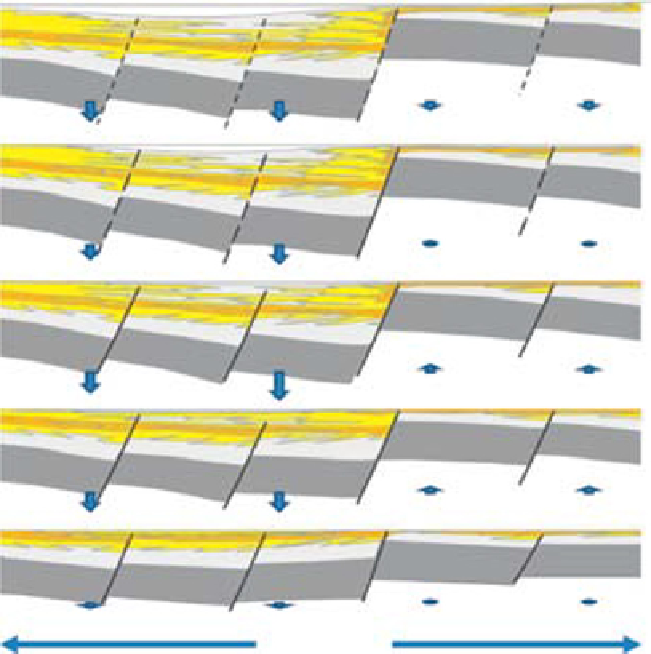Geoscience Reference
In-Depth Information
(C)
Halten Terrace
Tr øndelag Platform
Initial highstand
(basin margin) &
Maximum flooding
(basinal)
Minor and
localised
rotational
faulting
IX
Maximum flooding
(basin margin) &
Late transgression
(basinal)
Continued basinal
structuring,
waning rate of
rotational faulting
VIII
Continued basinal
structuring,
peak rate of
rotational faulting
Tr ansgression,
ctd. lowstand on
structural highs
VII
Continued basinal
structuring,
increasing rate of
rotational faulting
Early transgression,
lowstand on
structural highs
VI
Continued basinal
structuring, initial
rotational faulting
Late lowstand to
initial transgression
V
150-200 km
Fig. 12.
(
Continued
) Sediment supply from the left part is conceptually envisaged to represent intrabasinal provenances.
Deeper basins with departing subsidence and sediment supply histories may be present in the western (left) end of the
profile. The profile is an idealised section that represents trends observed along both the N-S and W-E profiles illustrated
by the well correlations in Figs 6, 8 and 10. Dark grey colour shading in B and C represent an older megasequence;
light grey is marine mudstones, yellow is marginal marine and deltaics undifferentiated and orange is fluvial sheet
sandstones.
attached depositional systems, either as transverse
or combined transverse-longitudinal deltas and
shorelines. The fronting shelfal to offshore area was
dominated by alternating muddy inner shelf and
gravity flow-dominated prodelta areas. The early
progradational phase of the basin-marginal systems
was often paralleled by the retreat (or aggradation)
of any intrabasinal sourced depositional system.
Forced regressive segment: The upper part of
the regressive segment is dominated by thinner
coarsening-upwards motif(s), again represent-
ing offshore-shoreface or prodelta-delta front-
distributary channel fill successions, often with
marked and abrupt facies tract boundaries. These
motif(s) are capped by erosively based, often
detached, fluviodeltaic lithosomes or multi-
storey-multilateral fluviodeltaic sheet sands.
These detached fluviodeltaic wedges or sheet
sands are, in turn, overlain by another forward-
stepping stack of rapidly coarsening-upwards
motifs of sandy fluviodeltaic lithosomes. This
represents a change to coastal and delta out-
building during falling relative sea-level to low-
stand situations and early stages of rising relative
sea-level or forced regressive or the falling stage
(Hunt & Tucker, 1992; Posamentier
et al
., 1992),
through early to late lowstand systems tract,
normal regressive (Van Wagoner
et al
., 1990;
Helland-Hansen & Gjelberg, 1994; Van Wagoner,
1995; Helland-Hansen & Martinsen, 1996) situa-
tions (Fig. 12B).
The forced regressive and lowstand units
sometimes continued the outbuilding patterns
from the underlying highstand situation, i.e. as
transverse or combined transverse-longitudinal
delta-shoreline systems, such as in the Tofte-ile
and Garn megasequences, often with the addi-
tional influx of sediment from local, intrabasinal

Search WWH ::

Custom Search